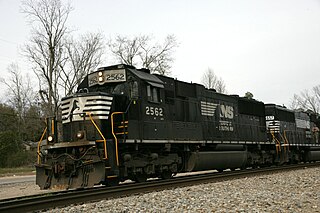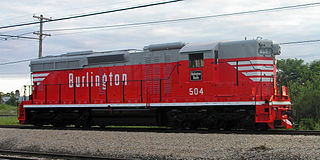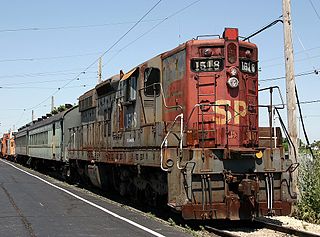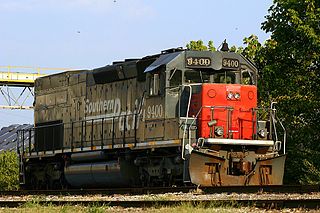
The SD80MAC was a 5,000 horsepower (3.7 MW) C-C diesel-electric locomotive. It was powered by a 20-cylinder version of EMD's 710G prime mover, and was the second diesel locomotive by GM-EMD to use a V20 engine, since EMD's SD45 series. It introduced a wide radiator housing similar to GE Transportation locomotives and the placement of dynamic brakes at the rear of the locomotive, which is a quieter location, features that were incorporated into the SD90MAC and SD70ACe models. Key spotting differences between the SD80MAC and SD90MAC include no external rear sandbox on the SD90MAC, no rear lighted number boards on the SD90MAC, and the placement of the front numberboards. The SD80MAC also had recessed red marker lights in the nose, an identifying feature unique to Conrail (CR) locomotives, although Norfolk Southern (NS) had removed the lights on most of their former Conrail engines.

The GE U25B is General Electric's first independent entry into the United States domestic road switcher diesel-electric locomotive railroad market for heavy production road locomotives since 1936. From 1940 through 1953, GE participated in a design, production, and marketing consortium (Alco-GE) for diesel-electric locomotives with the American Locomotive Company. In 1956 the GE Universal Series of diesel locomotives was founded for the export market. The U25B was the first attempt at the domestic market since its termination of the consortium agreement with Alco.

The EMD F7 is a model of 1,500-horsepower (1,100 kW) diesel-electric locomotive produced between February 1949 and December 1953 by the Electro-Motive Division of General Motors (EMD) and General Motors Diesel (GMD).

The EMD SD70 is a series of diesel-electric locomotives produced by the US company Electro-Motive Diesel. This locomotive family is an extension and improvisation to the EMD SD60 series. Production commenced in late 1992 and since then over 5,700 units have been produced; most of these are the SD70M, SD70MAC, and SD70ACe models. While the majority of the production was ordered for use in North America, various models of the series have been used worldwide. All locomotives of this series are hood units with C-C trucks, except the SD70ACe-P4 and SD70MACH which have a B1-1B wheel configuration, and the SD70ACe-BB, which has a B+B-B+B wheel arrangement.

The EMD SW1 is a 600-horsepower (450 kW) diesel-electric switcher locomotive built by General Motors' Electro-Motive Corporation between December 1938 and November 1953. Final assembly was at EMD's plant at LaGrange (McCook) Illinois. The SW1 was the second generation of 3,402 cu in (55.75 L) switcher from EMD, succeeding the SC and SW. The most significant change from those earlier models was the use of an engine of EMD's own design, the then-new 567 engine, here in 600 hp (450 kW) V6 form. 661 locomotives of this design were built, with a gap in production between March 1943 and September 1945 due to World War II.

The EMD SD24 was a 2,400 hp (1,800 kW) six-axle (C-C) diesel-electric locomotive built by General Motors' Electro-Motive Division of La Grange, Illinois between July 1958 and March 1963. A total of 224 units were built for customers in the United States, comprising 179 regular, cab-equipped locomotives and 45 cabless B units. The latter were built solely for the Union Pacific Railroad.

The EMD GP7 is a four-axle (B-B) diesel-electric locomotive built by General Motors Electro-Motive Division and General Motors Diesel between October 1949 and May 1954.

The SD7 is a model of 6-axle diesel locomotive built by General Motors Electro-Motive Division between May 1951 and November 1953. It had an EMD 567B 16-cylinder engine producing 1,500 horsepower (1.12 MW) for its six traction motors. United States railroads bought 188 units.

The EMD SD9 is a model of diesel locomotive built by General Motors Electro-Motive Division between January 1954 and June 1959. An EMD 567C 16-cylinder engine generated 1,750 horsepower (1.30 MW). Externally similar to its predecessor, the SD7, the SD9 was built with the improved and much more maintainable 567C engine.

The SD45 is a six-axle diesel-electric locomotive class built by General Motors Electro-Motive Division between 1965 and 1971. It has an EMD 645E3 twenty-cylinder engine generating 3,600 hp (2,680 kW) on the same frame as the SD38, SD39, SD40, and SDP40. As of 2023, most SD45s have been retired, scrapped or rebuilt to SD40-2 standards.

The SD45T-2 is a model of diesel-electric locomotive built by EMD for the Southern Pacific Railroad. Like the later SD40T-2 it is colloquially nicknamed a tunnel motor. 247 total units were produced from February 1972 to June 1975, including 84 for SP's subsidiary Cotton Belt. From April 1986 to December 1989, 126 were rebuilt and re-designated as SD45T-2R, including 24 for Cotton Belt.

An EMD GP40X is a 4-axle diesel-electric locomotive built by General Motors Electro-Motive Division between December 1977 and June 1978. Power for this unit was provided by a turbocharged 16-cylinder 16-645F3B engine which could produce 3,500 horsepower (2,610 kW). 23 examples of this locomotive were built for North American railroads. This unit was a pre-production version meant to test technologies later incorporated into EMD's 50-series locomotives GP50 and SD50.

The Portland and Western Railroad is a 516-mile (830 km) Class II railroad serving the U.S. state of Oregon, and is a wholly owned subsidiary of shortline and regional railroad holding company Genesee & Wyoming Inc. The PNWR includes a subsidiary, the Willamette and Pacific Railroad.

Southern Pacific Railroad (SP) number 1518 is an EMD SD7, and was the first ever SD series diesel locomotive, originally built in May 1951 as General Motors Electro-Motive Division's (EMD) prototype Demonstrator #990.

The ALCO RS-3m is a diesel-electric locomotive rebuilt from an ALCO RS-3 road switcher. These 98 locomotives were rebuilt to replace their original ALCO prime mover with the more reliable EMD 567B engine and fan assemblies taken from retired E8s. Many of these rebuilds were performed by the ex NYC DeWitt shop with 56 completed at the ex PRR Juniata shop. The RS3m rebuild program started in 1972 and continued until 1978 under Conrail.

The EMD SD45R was a rebuild from EMD SD45 diesel locomotives that were originally built between August 1966 and January 1970 for the Southern Pacific Transportation Company, but were rebuilt by the Southern Pacific themselves under the Southern Pacific's M-99 rebuild program between 1979 and 1985.

The EMD SD9E was a rebuild from EMD SD9 diesel locomotives that were built by General-Motors Electro-Motive Division for the Southern Pacific Transportation Company.

The EMD GP9R was a rebuild from EMD GP9 diesel locomotives that were rebuilt by the Chicago and North Western Transportation Company, Grand Trunk Western Railroad, Southern Pacific Transportation Company.



















